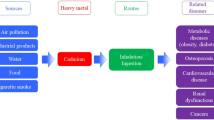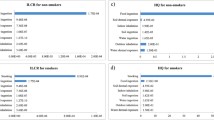Abstract
Cadmium (Cd), poisoning has been reported from all around the World, causing many deaths annually. Cd is a toxic heavy metal, and is widely present in environment. It has been reported that chronic Cd exposure is associated with kidney disease, osteoporosis, cardiovascular diseases and cancer. Smoking causes exposure to significantly higher Cd levels in humans. Tobacco smoke transports Cd into the lungs. Blood then transport it to the rest of the body where it increases effects by potentiating Cd that is already present from Cd-rich food. Other high exposures of Cd can occur with people, who live near hazardous waste sites, or factories that release Cd into the air and people who work in the metal refinery industry. Breathing of Cd can severely damage the lungs and may even cause death. Multiple studies have shown an association between environmental exposure to hazardous chemicals including toxic metals and obesity, diabetes, and metabolic syndrome. At the same time, the existing data on the impact of Cd exposure on obesity and diabetes are contradictory. On the converse, results of epidemiologic studies linking Cd exposure and Osteoporosis, overweight or obesity are far less consistent and even conflicting, also depending on differences in exposure levels. In turn, laboratory studies demonstrated that Cd adversely affects adipose tissue physiopathology through several mechanisms, thus contributing to increased insulin resistance and enhancing diabetes. However, intimate biological mechanisms linking Cd exposure with human diseases are still to be adequately investigated. Therefore, the aim of the present review was to explore the impact of Cd exposure and status on the risk of Cd in human diseases.



Similar content being viewed by others
References
Bernhoft RA. Cadmium toxicity and treatment. Sci World J. 2013;2013:394652.
Sato M, Kondoh M. Recent studies on metallothionein: protection against toxicity of heavy metals and oxygen free radicals. Tohoku J Exp Med. 2002;196:9–22.
Hassoun EA, Stohs SJ. Cadmium-induced production of superoxide anion and nitric oxide, DNA single strand breaks and lactate dehydrogenase leakage in J774A.1 cell cultures. Toxicology. 1996;112:219–26.
Filipic M, Fatur T, Vudrag M. Molecular mechanisms of cadmium induced mutagenicity. Hum Exp Toxicol. 2006;25:67–77.
Koedrith P, Seo YR. Advances in carcinogenic metal toxicity and potential molecular markers. Int J Mol Sci. 2011;12:9576–95.
Rikans LE, Yamano T. Mechanisms of cadmium mediated acute hepatotoxicity. J Biochem Mol Toxicol. 2000;14:110–7.
Lin YS, Caffrey JL, Chang MH, Dowling N, Lin JW. Cigarette smoking, cadmium exposure and zinc intake on obstructive lung disorder. Respir Res. 2010;11:53.
Erie JC, Good JA, Butz JA, Hodge DO, Pulido JS. Urinary cadmium and age-related macular degeneration. Am J Ophthalmol. 2007;144:414–8.
Castellanos MJ, Fuente A. The adverse effects of heavy metals with and without noise exposure on the human peripheral and central auditory system: a literature review. Int J Environ Res Public Health. 2016;13:1223.
Chantarawong W, Takeda K, Sangartit W, Yoshizawa M, Pradermwong K, Shibahara S. Microphthalmiaassociated transcription factor as the molecular target of cadmium toxicity in human melanocytes. Biochem Biophys Res Commun. 2014;454:594–9.
Jaishankar M, Tseten T, Anbalagan N, Mathew BB, Beeregowda KN. Toxicity mechanism and health effects of some heavy metals. Interdiscip Toxicol. 2014;7:60–72.
Puri VN. Cadmium induced hypertension. Clin Exp Hypertens. 1999;21:79–84.
Satarug S, Nishijo M, Ujjin P, Vanavanitkun Y, Moore MR. Cadmium-induced nephropathy in the development of high blood pressure. Toxicol Lett. 2005;157:57–68.
Eum KD, Lee MS, Paek D. Cadmium in blood and hypertension. Sci Total Environ. 2008;407:147–53.
Prozialeck WC, Edwards JR, Nebert DW, Woods JM, Barchowsky A, Atchison WD. The vascular system as a target of metal toxicity. Toxicol Sci. 2008;102:207–18.
Messner B, Bernhard D. Cadmium and cardiovascular diseases: cell biology, pathophysiology and epidemiological relevance. Biometals. 2010;23:811–22.
Nordberg GF. Cadmium and health in the 21st century: historical remarks and trends for the future. Biometals. 2004;17:485–9.
Aoshima K. Itai-itai disease: cadmium-induced renal tubular osteomalacia. Nihon Eiseigaku Zasshi. 2012;67:455–63.
Cai SW, Yue L, Hu ZN, Zhong XZ, Ye ZL, Xu HD, et al. Cadmium exposure and health effects among residents in an irrigation area with ore dressing wastewater. Sci Total Environ. 1990;90:67–73.
Satarug S, Moore MR. Adverse health effects of chronic exposure to low-level cadmium in foodstuffs and cigarette smoke. Environ Health Perspect. 2004;112:1099–103.
Simmons RW, Pongsakul P, Saiyasitpanich D, Klinphoklap S. Elevated levels of cadmium and zinc in paddy soils and elevated levels of cadmium in rice grain downstream of a zinc mineralized area in Thailand: implications for public health. Environ Geochem Health. 2005;27:501–11.
Srikanth R, Khanam A, Rao V. Cadmium levels in the urine of male sewage sludge farmers of Hyderabad. India J Toxicol. Environ Health. 1994;43:1–6.
Jin T, Nordberg G, Ye T, Bo M, Wang H, Zhu G, et al. Osteoporosis and renal dysfunction in a general population exposed to cadmium in China. Environ Res. 2004;96:353–9.
Bandara JM, Wijewardena HV, Bandara YM, Jayasooriya RG, Rajapaksha H. Pollution of River Mahaweli and farmlands under irrigation by cadmium from agricultural inputs leading to a chronic renal failure epidemic among farmers in NCP Sri Lanka. Environ Geochem Health. 2011;33:439–53.
Limpatanachote P, Swaddiwudhipong W, Mahasakpan P, Krintratun S. Cadmium-exposed population in Mae Sot District Tak Province: 2. Prevalence of renal dysfunction in the adults. J Med Assoc Thai. 2009;92:1345–53.
Songprasert N, Sukaew T, Kusreesakul K, Swaddiwudhipong W, Padungtod C, Bundhamcharoen K. Additional burden of diseases associated with cadmium exposure: a case study of cadmium contaminated rice fields in Mae Sot District, Tak Province, Thailand. Int. J. Environ. Res Public Health. 2015;12:9199–217.
Swaddiwudhipong W, Limpatanachote P, Mahasakpan P, Krintratun S, Padungtod C. Cadmium-exposed population in Mae Sot District, Tak Province: 1. Prevalence of high urinary cadmium levels in the adults. J Med Assoc Thai. 2007;90:143–8.
Baek K, Chung I. Cadmium exposure is associated with monocyte count and monocyte to HDL ratio, a marker of inflammation and future cardiovascular disease in the male population. J Korean Med Sci. 2017;32:1415–22.
Tellez-Plaza M, Guallar E, Howard BV, Umans JG, Francesconi KA, Goessler W, et al. Cadmium exposure and incident cardiovascular disease. Epidemiology. 2013;24:421–9.
Kisling GM, Kopp SJ, Paulson DJ, Tow JP. Cadmium-induced attenuation of coronary blood flow in the perfused rat heart. Toxicol Appl Pharmacol. 1993;118:58–64.
Kukongviriyapan U, Pannangpetch P, Kukongviriyapan V, Donpunha W, Sompamit K, Surawattanawan P. Curcumin protects against cadmium-induced vascular dysfunction hypertension and tissue cadmium accumulation in mice. Nutrients. 2014;6:1194–208.
Yamamoto C, Kaji T, Sakamoto M, Kozuka H. Cadmium stimulation of plasminogen activator inhibitor-1 release from human vascular endothelial cells in culture. Toxicology. 1993;83:215–23.
Szuster-Ciesielska A, Lokaj I, Kandefer-Szerszen M. The influence of cadmium and zinc ions on the interferon and tumor necrosis factor production in bovine aorta endothelial cells. Toxicology. 2000;145:135–45.
Hernandez M, Macia M. Free peripheral sulfhydryl groups, CD11/CD18 integrins, and calcium are required in the cadmium and nickel enhancement of human-polymorphonuclear leukocyte adherence. Arch Environ Contam Toxicol. 1996;30:437–43.
Kusaka Y, Kelly RA, Williams GH, Kifor I. Coronary microvascular endothelial cells cosecrete angiotensin II and endothelin-1 via a regulated pathway. Am J Physiol Heart Circ Physiol. 2000;279:1087–96.
Pereira FE, Coffin JD, Beall HD. Activation of protein kinase C and disruption of endothelial monolayer integrity by sodium arsenite: potential mechanism in the development of atherosclerosis. Toxicol Appl Pharmacol. 2007;220:164–77.
Satarug S, Nishijo M, Lasker JM, Edwards RJ, Moore MR. Kidney dysfunction and hypertension: role for cadmium, p450 and heme oxygenases? Tohoku J Exp Med. 2006;208:179–202.
Wu H, Liao Q, Chillrud SN, Yang Q, Huang L, Bi J, et al. Environmental exposure to cadmium: health risk assessment and its associations with hypertension and impaired kidney function. Sci Rep. 2016;6:29989.
Sundblad BM, Ji J, Levänen B, Midander K, Julander A, Larsson K, et al. Extracellular cadmium in the bronchoalveolar space of long-term tobacco smokers with and without COPD and its association with inflammation. Int J Chron Obstruct Pulmon Dis. 2016;11:1005–13.
Olszowski T, Baranowska-Bosiacka I, Gutowska I, Chlubek D. Pro-inflammatory properties of cadmium. Acta Biochim Pol. 2012;59:475–82.
Odewumi C, Latinwo L, Sinclair A, Badisa V, Abdullah A, Badisa R. Effect of cadmium on the expression levels of interleukin-1α and interleukin-10 cytokines in human lung cells. Mol Med Rep. 2015;12:6422–6.
Papa V, Wannenes F, Crescioli C, Caporossi D, Lenzi A, Migliaccio S, et al. The environmental pollutant cadmiuminduces homeostasis alteration inmuscle cells in vitro. J Endocrinol Investig. 2014;37:1073–80.
Ramyaa P, Krishnaswamy R, Padma V. Quercetin modulates OTA-induced oxidative stress and redox signalling in HepG2 cells-up regulation of Nrf2 expression and down regulation of NF-κB and COX-2. Biochim Biophys Acta. 2014;1840:681–92.
Kido T, Nogawa K, Yamada Y, Honda R, Tsuritani I, Ishizaki M, et al. Osteopenia in inhabitants with renal dysfunction induced by exposure to environmental cadmium. Int Arch Occup Environ Health. 1989;61:271–6.
Kjellström T. Mechanism and epidemiology of bone e Vects of cadmium. IARC Sci Publ. 1992;118:301–10.
Kido T, Nogawa K, Honda R, Tsuritani I, Ishizaki M, Yamada Y, et al. The association between renal dysfunction and osteopenia in environmental cadmium-exposed subjects. Environ Res. 1990;51:71–82.
Aoshima K, Kasuya M. Preliminary study on serum levels of 1,25-dihydroxyvitamin D and 25-hydroxyvitamin D in cadmium-induced renal tubular dysfunction. Toxicol Lett. 1991;57(91–9):438.
Tsuritani I, Honda R, Ishizaki M, Honda R, Yamada Y, Ishizaki M. Impairment of vitamin D metabolism due to environmental cadmium exposure, and possible relevance to sex-related diVerences in vulnerability to the bone damage. J Toxicol Environ Health. 1992;37:519–33.
Kazantzis G. Renal tubular dysfunction and abnormalities of calcium metabolism in cadmium workers. Environ Health Perspect. 1979;28:155–9.
Bhattacharyya MH, Sacco-Gibson NA, Peterson DP. Cadmium-induced bone loss: increased susceptibility in female beagles after ovariectomy. IARC Sci Publ. 1992;118:279–86.
Kazantzis G. Cadmium, osteoporosis and calcium metabolism. Biometals. 2004;17:493–8.
Wild S, Roglic G, Green A, Sicree R, King H. Global prevalence of diabetes: estimates for the year 2000 and projections for 2030. Diabetes Care. 2004;27:1047–53.
Cackovic M, Kalinic N, Vadjic V, Pehnec G. Heavy metals and acidic components in total deposited matter in sibenik and national park kornati, croatia. Arch Environ Contam Toxicol. 2009;56:12–20.
Yang QW, Li H, Long FY. Heavy metals of vegetables and soils of vegetable bases in Chongqing, Southwest China. Environ. Monit. Assess. 2007;130:271–9.
Diawara MM, Litt JS, Unis D, Alfonso N, Martinez L, Crock JG, et al. Arsenic, cadmium, lead, and mercury in surface soils, Pueblo, Colorado: implications for population health risk. Environ Geochem Health. 2006;28:297–315.
Jarup L. Cadmium overload and toxicity. Nephrol Dial Transplant. 2002;17:35–9.
Prozialeck WC, Vaidya VS, Liu J, Waalkes MP, Edwards JR, Lamar PC, et al. Kidney injury molecule-1 is an early biomarker of cadmium nephrotoxicity. Kidney Int. 2007;72:985–93.
Bernard A. Renal dysfunction induced by cadmium: biomarkers of critical effects. Biometals. 2004;17:519–23.
Author information
Authors and Affiliations
Corresponding author
Ethics declarations
Conflict of interest
The authors declare that they have no conflict of interest.
Additional information
Publisher's Note
Springer Nature remains neutral with regard to jurisdictional claims in published maps and institutional affiliations.
Rights and permissions
About this article
Cite this article
Fatima, G., Raza, A.M., Hadi, N. et al. Cadmium in Human Diseases: It’s More than Just a Mere Metal. Ind J Clin Biochem 34, 371–378 (2019). https://doi.org/10.1007/s12291-019-00839-8
Received:
Accepted:
Published:
Issue Date:
DOI: https://doi.org/10.1007/s12291-019-00839-8




